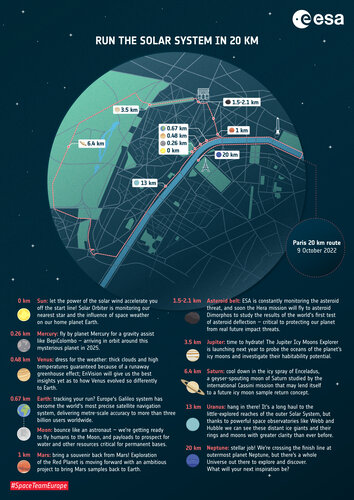Launching rockets into space may be our regular business, but on 9 October Space Team Europe is at a very different kind of start line: at the space-themed Paris 20 km running event. Nearly 150 colleagues from ESA, CNES, ArianeGroup and Arianespace are uniting forces to highlight the power of collaboration, taking part in either the in-person event or the virtual experience in their home towns across Europe. Ambitions are high to complete the 20 km race, but Sunday’s Space Team Europe represents a much larger and diverse community driven by the same vision and ambition for excellence – to excel as a world-leading and inspiring space agency.
Whether you’re taking part in the event yourself, participating virtually, planning your own 20 km run this weekend, or cheering from the sidelines, this graphic imagines the route through Paris as a scaled tour through the Solar System. Full sight-seeing tour details below!
The Solar System in 20 km
GO! We’re starting our journey at the centre of our Solar System with the Sun – let the power of the solar wind accelerate you off the start line! Our ESA-led Solar Orbiter mission is monitoring our nearest star and the influence of space weather on our home planet Earth.
It’s a whistle-stop tour of the inner Solar System planets as we need to squeeze Mercury, Venus, Earth and Mars all into the first kilometre. Fly by planet Mercuryat just 260 m into the race for a gravity assist like our joint ESA/JAXA BepiColombo mission – arriving in orbit around this mysterious planet in 2025.
Then it’s on to Venus at 480 m, but dress for the weather: thick clouds and high temperatures guaranteed because of a runaway greenhouse effect, a stark warning for extreme climate change. Our future mission EnVision will give us the best insights yet as to how Venus evolved so differently to Earth.
Space exploration starts at your home planet Earth, 670 m into our scaled run and a good time to double check you remembered to turn your sports watch on! Europe's Galileo system has become the world's most precise satellite navigation system, delivering metre-scale accuracy to more than three billion users worldwide. Maybe you’re running on a treadmill today instead; astronauts onboard the International Space Station need to run in space to preserve their muscle and bone strength – using elastic bands to keep them from floating off the treadmill. ESA astronaut Tim Peake even ran a marathon in space, finishing in just 3 hours and 35 minutes. During that time he travelled over 100 000 km as the International Space Station orbited around our planet – quite the ultra!
A short bounce forward brings us to the Moon, where ESA and its international partners are getting ready to fly crewed missions, along with payloads to prospect for water and other resources critical for permanent bases. We’re also planning a constellation of telecom and satnav satellites around the Moon …soon you’ll be able to track your lunar marathons, too!
Marsbrings us to the 1 km marker. Think of the medal you get at the end of a race while we’re working on an out of this world ‘souvenir’ like no other: exploration of the Red Planet foresees an ambitious project to bring Mars samples back to Earth.
Watch out for falling rocks as we navigate through the Asteroid beltbetween about 1.5 and 2.1 km. ESA is constantly monitoring the asteroid threat, and soon the Hera mission will fly to asteroid Dimorphos to study the results of the world's first test of asteroid deflection – critical to protecting our planet from real future impact threats.
Don’t forget to hydrate as we pass by Jupiterat 3.5 km. ESA’s Jupiter Icy Moons Explorer is launching next year to probe the oceans of the planet’s icy moons and investigate their habitability potential.
Cool down in the icy spray of Enceladus, a geyser-spouting moon of Saturn at 6.4 km. This water-world was studied by the International Cassini mission and it may lend itself to an ambitious future icy moon sample return concept.
Hang in there! It’s a long haul to the little-explored reaches of the outer Solar System, with Uranusout at about 13 km. But thanks to powerful space observatories like Webb and Hubble, which orbit close to Earth, we can see the distant ice giants and their rings and moons with greater clarity than ever before.
Stellar job! We’re crossing the finish line at 20 km at outermost planet Neptune, but there’s a whole Universe out there to explore and discover. What will your next inspiration be?
Distances are approximate

 Image:
Run the Solar System in 20 km
Image:
Run the Solar System in 20 km